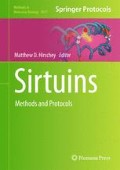Abstract
Calorie restriction is the most powerful method currently known to delay aging-associated disease and extend lifespan. Use of this technique in combination with genetic models has led to identification of key metabolic regulators of lifespan. Limiting energy availability by restricting caloric intake leads to redistribution of energy expenditure and storage. The signaling required for these metabolic changes is mediated in part by the sirtuins at both the posttranslational and transcriptional levels, and consequently, sirtuins are recognized as instigating factors in the regulation of lifespan. This family of class III protein deacetylases is responsible for directing energy regulation based on NAD+ availability. However, there are many effectors of NAD+ availability, and hence sirtuin action, that should be considered when performing experiments using calorie restriction. The methods outlined in this chapter are intended to provide a guide to help the aging community to use and interpret experimental calorie restriction properly. The importance of healthspan and the use of repeated measures to assess metabolic health during lifespan experiments are strongly emphasized.
Access this chapter
Tax calculation will be finalised at checkout
Purchases are for personal use only
References
Reaven E, Wright D, Mondon CE, Solomon R, Ho H, Reaven GM (1983) Effect of age and diet on insulin secretion and insulin action in the rat. Diabetes 32(2):175–180
Taylor A, Zuliani AM, Hopkins RE et al (1989) Moderate caloric restriction delays cataract formation in the Emory mouse. FASEB J 3(6):1741–1746
Young JB, Mullen D, Landsberg L (1978) Caloric restriction lowers blood pressure in the spontaneously hypertensive rat. Metab Clin Exp 27(12):1711–1714
Yu ZF, Mattson MP (1999) Dietary restriction and 2-deoxyglucose administration reduce focal ischemic brain damage and improve behavioral outcome: evidence for a preconditioning mechanism. J Neurosci Res 57(6):830–839
Means LW, Higgins JL, Fernandez TJ (1993) Mid-life onset of dietary restriction extends life and prolongs cognitive functioning. Physiol Behav 54(3):503–508
Mattson MP (2010) The impact of dietary energy intake on cognitive aging. Front Aging Neurosci 2:5
McCay CM, Crowell MF, Maynard LA (1935) The effect of retarded growth upon the length of life span and upon the ultimate body size. J Nutr 10(1):63–79
Spindler SR (2010) Caloric restriction: from soup to nuts. Ageing Res Rev 9(3):324–353
Nogueiras R, Habegger KM, Chaudhary N et al (2012) Sirtuin 1 and sirtuin 3: physiological modulators of metabolism. Physiol Rev 92(3):1479–1514
Picard F, Kurtev M, Chung N et al (2004) Sirt1 promotes fat mobilization in white adipocytes by repressing PPAR-gamma. Nature 429(6993):771–776
Rodgers JT, Lerin C, Haas W, Gygi SP, Spiegelman BM, Puigserver P (2005) Nutrient control of glucose homeostasis through a complex of PGC-1alpha and SIRT1. Nature 434(7029):113–118
Moynihan KA, Grimm AA, Plueger MM et al (2005) Increased dosage of mammalian Sir2 in pancreatic beta cells enhances glucose-stimulated insulin secretion in mice. Cell Metab 2(2):105–117
Lin SJ, Defossez PA, Guarente L (2000) Requirement of NAD and SIR2 for life-span extension by calorie restriction in Saccharomyces cerevisiae. Science 289(5487): 2126–2128
Wood JG, Rogina B, Lavu S et al (2004) Sirtuin activators mimic caloric restriction and delay ageing in metazoans. Nature 430(7000): 686–689
Cohen HY, Miller C, Bitterman KJ et al (2004) Calorie restriction promotes mammalian cell survival by inducing the SIRT1 deacetylase. Science 305(5682):390–392
Boily G, Seifert EL, Bevilacqua L et al (2008) SirT1 regulates energy metabolism and response to caloric restriction in mice. PLoS One 3(3):e1759
Cheng H-L, Mostoslavsky R, Saito S et al (2003) Developmental defects and p53 hyperacetylation in Sir2 homolog (SIRT1)-deficient mice. Proc Natl Acad Sci U S A 100(19): 10794–10799
McBurney MW, Yang X, Jardine K et al (2003) The mammalian SIR2alpha protein has a role in embryogenesis and gametogenesis. Mol Cell Biol 23(1):38–54
Bordone L, Cohen D, Robinson A et al (2007) SIRT1 transgenic mice show phenotypes resembling calorie restriction. Aging Cell 6(6): 759–767
Herranz D, Muñoz-Martin M, Cañamero M et al (2010) Sirt1 improves healthy ageing and protects from metabolic syndrome-associated cancer. Nat Commun 1:3
Pfluger PT, Herranz D, Velasco-Miguel S, Serrano M, Tschöp MH (2008) Sirt1 protects against high-fat diet-induced metabolic damage. Proc Natl Acad Sci USA 105(28): 9793–9798
Minor RK, Baur JA, Gomes AP et al (2011) SRT1720 improves survival and healthspan of obese mice. Sci Rep 1:70
Mattison JA, Roth GS, Beasley TM et al (2012) Impact of caloric restriction on health and survival in rhesus monkeys from the NIA study. Nature 489(7415):318–321
Colman RJ, Anderson RM, Johnson SC et al (2009) Caloric restriction delays disease onset and mortality in rhesus monkeys. Science 325(5937):201–204
Ayala JE, Samuel VT, Morton GJ et al (2010) Standard operating procedures for describing and performing metabolic tests of glucose homeostasis in mice. Dis Model Mech 3(9–10):525–534
Tschöp MH, Speakman JR, Arch JRS et al (2012) A guide to analysis of mouse energy metabolism. Nat Methods 9(1):57–63
Merry BJ (2002) Molecular mechanisms linking calorie restriction and longevity. Int J Biochem Cell Biol 34(11):1340–1354
Starr ME, Saito H (2012) Age-related increase in food spilling by laboratory mice may lead to significant overestimation of actual food consumption: implications for studies on dietary restriction, metabolism, and dose calculations. J Gerontol A Biol Sci Med Sci 67(10): 1043–1048
Acknowledgements
Dawn Boyer, Dawn Nines, and Justine Lucas for their continuous support and assistance with our animal studies. Dr. Anson for providing helpful feedback on this manuscript. This work was supported by the Intramural Research Program of the National Institute on Aging, NIH.
Author information
Authors and Affiliations
Editor information
Editors and Affiliations
Rights and permissions
Copyright information
© 2013 Springer Science+Business Media, LLC
About this protocol
Cite this protocol
Curtis, J., de Cabo, R. (2013). Utilizing Calorie Restriction to Evaluate the Role of Sirtuins in Healthspan and Lifespan of Mice. In: Hirschey, M. (eds) Sirtuins. Methods in Molecular Biology, vol 1077. Humana Press, Totowa, NJ. https://doi.org/10.1007/978-1-62703-637-5_20
Download citation
DOI: https://doi.org/10.1007/978-1-62703-637-5_20
Published:
Publisher Name: Humana Press, Totowa, NJ
Print ISBN: 978-1-62703-636-8
Online ISBN: 978-1-62703-637-5
eBook Packages: Springer Protocols

